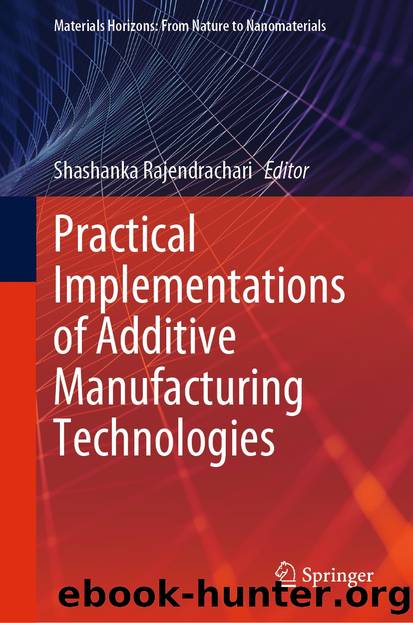Practical Implementations of Additive Manufacturing Technologies by Unknown

Author:Unknown
Language: eng
Format: epub
ISBN: 9789819959495
Publisher: Springer Nature Singapore
5.2 Shape Memory Polymers
Shape memory polymer (SMP) is ideal for 4D printing applications due to its versatile processing capabilities required for different AM technologies. SMPs are a class of polymeric materials that can be programmed to remember a specific configuration and flip that structure over when exposed to external stimuli. Low cost, light weight, and good resilience are the main features of SMP. Heat, light, electricity, humidity, and magnetism can act as stimuli on SMP structures and produce SME. SMPs can maintain two or more morphologies upon exposure to stimuli. A triple SMP can be enough to memorize two temporary shapes and restore the original shape sequentially when heating. A triple SME can be introduced by incorporating two SMPs with different transition temperatures into the polymer network or by introducing one SMP with a higher transition temperature. A recent experimental study of triplet SMPs printed by FDM devices showed a hyperelastic response at high temperatures and an elastoplastic response at low temperatures over a wide range of strain. A two-component mechanism, a two-state mechanism, and a partial transition mechanism drive the SME of SMP. The shape recovery mechanism depends on the glass transition temperature (Tg) of the specific SMP. This is completely different from SMA. SMPs can be easily adjusted to the environment/application by controlling the crystalline content of the polymer, which can be used to program transition temperatures such as Tg and Tm. Tg is the temperature at which the momentum of the molecule in the glassy state becomes relatively low. A complete SME was observed in thermally activated SMPs when heated above their Tg temperature. On the other hand, the elastic entropy of polymer chains drives the stress recovery mechanism of SMP. Shape recovery depends entirely on the material's capabilities and the application of specific stimuli during specific time intervals [45].
Heat is by far the most widely used stimulus in 4D printing, with temperature differences triggering reactions that promote self-assembly, self-healing, and shape memory in the materials in question. Direct or indirect heating is used in particular light-activated SMP applications. Magnetic, ultrasonic, microwave, or electrical are inherently sensitive to heat, depending on the additives used in the matrix. Physically or chemically cross-linked thermosensitive polymers can be viewed as double, triple, or multiple SMPs. A significant number of such polymers have been reported to recover their original shape, although slight reversibility of temporary and permanent shapes has been demonstrated upon stimulus interaction. The shape memory mechanism operates at working temperatures above and below the Tg or Tm required for mechanical breakdown and subsequent temporary shape formation. Light is another switching stimulus that can be easily activated due to its intensity, wavelength, and polarization, allowing for touchless control. SMPs containing photosensitive functional groups (such as azobenzene or cinnamic acid) are potential candidates for this class of polymers. Chen et al. [46] prepared a PBS/PLA polymer blend that showed tremendous photothermal effects. Several organic compounds and polymers are highly photon-absorbing and increase their internal temperature due to their high light absorption.
Download
This site does not store any files on its server. We only index and link to content provided by other sites. Please contact the content providers to delete copyright contents if any and email us, we'll remove relevant links or contents immediately.
Learning SQL by Alan Beaulieu(5994)
Weapons of Math Destruction by Cathy O'Neil(5778)
Digital Minimalism by Cal Newport;(5323)
iGen by Jean M. Twenge(5125)
Sapiens by Yuval Noah Harari(5094)
The Age of Surveillance Capitalism by Shoshana Zuboff(3946)
Elon Musk by Ashlee Vance(3824)
Thing Explainer by Randall Munroe(3751)
Apollo 8 by Jeffrey Kluger(3480)
Future Crimes by Marc Goodman(3345)
The Science Book (Big Ideas Simply Explained) by DK(3113)
Who Can You Trust? by Rachel Botsman(3013)
I Live in the Future & Here's How It Works by Nick Bilton(2817)
Infinite Energy Technologies by Finley Eversole(2807)
Steve Jobs by Walter Isaacson(2728)
Dawn of the New Everything by Jaron Lanier(2668)
Chernobyl by Serhii Plokhy(2416)
Ben Franklin's Almanac by Candace Fleming(2363)
Energy Myths and Realities by Vaclav Smil(2350)
